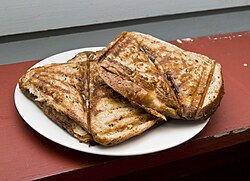FR is "corn" the same thing they call corn here? Ie the little yellow things on a stalk? If so why would you preserve it, best way to eat it is to buy a fresh corn cob (with the husk still on it) and throw it on the barby or in the oven (or an open fire). It SOOO sweet and juicy

The Brits call it "maize," most cultures recognize that name even if it's not the one they use. It sounds like you're talking about the same thing. Yellow kernels arranged in rows around a roughly cylindrical "cob," with large leaves wrapped around it. The whole thing is about a foot long.
Served the way you describe it, "on the cob," is popular. The traditional American way to cook it whole is to boil it, but grilling is becoming popular as the country is in the throes of a "let's barbecue everything" fad. But corn is a seasonal crop and fresh corn is not available all year round. When it's out of season you have to eat it canned or frozen.
The alkali is not used as a preservative, but merely to remove the hulls. As I mentioned, some people like myself can't digest whole corn kernels so turning it into hominy by removing the hulls makes it possible for us to eat it at all. Hominy is also smoother and easier to work with.
I'm from the Southwest where we have Mexican traditions so we often eat our corn in other ways. The most ubiquitous is
tortillas, which are thin, flat, round patties of corn flour baked or grilled, and served hot to fill the place in the meal which bread occupies in European cuisine. Roll them up with pork or chicken and other ingredients inside to make soft
tacos, fill them and fold them in half then deep fry them to make hard
tacos, completely enclose the filling and cover them with
salsa and cook them that way to make
enchiladas, the recipes are endless.
Tamales are made by rolling pork, chicken or cheese in a thick corn flour
(masa), wrapping the whole thing in a couple of corn leaves, tying it up with string and steaming a pot full of them for an hour or so. There are also smaller, thicker corn tortillas called
gorditas that are stuffed with hot filling. Tortillas are also eaten as a side dish like bread, with salsa or butter.
You can also use goat meat, which is incredibly tender, if you can get it. People in Texas make Mexican recipes with beef instead of pork because they are cattle ranchers, but that's not very authentic, not half as tasty, and we call it "Tex-Mex." (To be fair they also raise cattle in the northeastern states of Mexico that are close to Texas, but many Mexicans can't afford to eat beef.)
Hominy is a common ingredient in more elaborate Mexican dishes. The ones I've described are simple and easy (although labor-intensive) and the staples of fast food joints.
Larger, sturdier tortillas can be made out of wheat flour, and are filled and rolled over on the ends to make
burritos. Of course Mexicans also eat bread and wheat-flour pastry.
Since corn is our native grain in America we eat it in many ways. Highly processed corn flakes are a popular breakfast cereal, cornmeal bread or "cornbread" is a side dish with butter and honey, and hominy "grits" is a Southeastern dish I've never tried.
We use cornmeal to dredge chicken or fish for deep frying. One of my favorite meals is deep fried catfish with "hush puppies," which are blobs of the extra corn batter deep fried by themselves. Legend says they're called that because fisherman would fry up the remnants of their batter and give it to their dogs after their own meal to settle them down.


